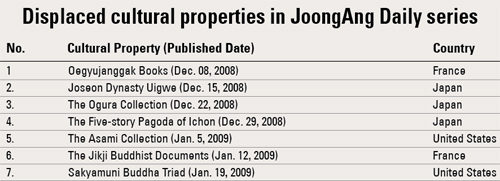Pros and cons of repatriating cultural relics

We selected a specific cultural property each week, gave an overview of its history, and examined what steps, if any, have been taken to ensure the return of the lost relics, or indeed whether repatriation is at all appropriate.
When selecting a cultural property, we consulted with the Cultural Heritage Administration as well as other experts to make sure the artifact is of high value and interest.
Many of the cultural properties we featured were actually already making headlines elsewhere, as many of these properties are the subject of intense media speculation and public interest.
As we covered the issues, we came across a number of experts who cautioned against simplistic nationalistic belief that because something’s ours, it has to be returned.
They argue that it’s not so important where a cultural property is kept and in whose possession, as much as how the item in question is preserved and made available for study by scholars worldwide.
Some even contend it’s better for the items to remain in countries like the United States and France, where many Korean cultural properties are kept today.
Others disagree, saying the value of a historic relic gets “lost in translation,” so to speak, or that it loses its significance when kidnapped and detached from its original historical and geographical context. They say restoring the relics back to Korea could lead to increased numbers of foreign visitors. After all, Korean traditional houses, hanok, look best on Korean soil just as pyramids fit best in the Egyptian desert, they say.
One thing is certain: It’s a very sensitive subject.
The fourth clause of the declaration issued at the recent Unesco meeting on the issue states the following: “It is not appropriate to apply the same exacting standards of proof in respect of heritage displaced during armed conflict, colonial rule, occupation or wrongful activity as might be required in other cases.”
Korea has a long history of foreign invasion due to its geographic location, which is arguably the main reason some 80,000 Korean artifacts have ended up in foreign lands. But as the clause indicates, and the experts we met explained, artifacts taken during invasion should be an exception.
But the first and second clauses of the declaration that emphasize human rights may be prescient here. They indicate that cultural properties are the sovereign property of the people who construct the heritage identity.
Finally, some voiced concern that civic groups and their activities could work against government negotiations.
While civic groups have the leverage to appeal to the public, they hope to see them join forces with government officials who have the contacts and expertise to handle these priceless, irreplaceable legacies.
By Kim Hyung-eun Staff Reporter [hkim@joongang.co.kr]










with the Korea JoongAng Daily
To write comments, please log in to one of the accounts.
Standards Board Policy (0/250자)